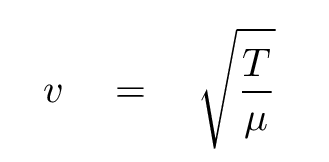
 Copyright © Michael Richmond.
This work is licensed under a Creative Commons License.
Copyright © Michael Richmond.
This work is licensed under a Creative Commons License.
In class on Monday, Nov 25 = Week 14, Day A, Fiacco-sensei plucked one of the strings on her cello, creating a deep musical note. Below is a very cursory summary of some information you can use to determine the tension in that string on her cello. We will discuss all of this in much greater detail in class.
If a string is stretched between two posts, so that its tension is T, and then one end is plucked or struck, a wave will travel down the string. The speed of that wave depends on the tension T and the linear mass density of the string μ in the following way:

When such a string is plucked, waves run down the string, reflect off the post at the far end, and run back toward the start. The waves travelling in one direction interfere with the waves travelling in the other direction (as we will discuss in class), creating a set of "standing waves". These are the waves which create the nice sounds we hear from instruments such as violins, cellos, and pianos.
Standing waves must have wavelengths which "fit" into the string on which they vibrate: the amplitude of the wave must be zero at each end of the string. There is a longest possible standing wave, called the fundamental, and then a number of shorter waves, called overtones. The graph below shows the fundamental and first overtone waves on Fiacco-sensei's cello string.

When one plucks a cello string, the sound we hear corresponds to the fundamental wave.
Q: What is the wavelength of this wave, on Fiacco-sensei's cello string? Q: What was the frequency of this wave? (What sound did we hear?)
You are familiar with one expression for the speed of a wave, based on its angular frequency and wave number.

But the angular frequency (in radians per second) is simply related to the frequency (in cycles per second, or Hz),

and the wave number (radians per meter) is related to the wavelength (meters)

So, if we wish, we can express the velocity of a wave in terms of its frequency (in Hz) and wavelength (in meters) like so:

Q: Use the wavelength and frequency of this wave to compute
its speed as it ran along the cello string.
(Hint: it should be a lot faster than a car on the highway)
Ha! Now that you know the speed of this wave, you can go back to the relationship between speed and tension, and figure out the tension of the string.
Q: What was the tension in the cello string?
(Hint: an ordinary human can exert this much force)
 Copyright © Michael Richmond.
This work is licensed under a Creative Commons License.
Copyright © Michael Richmond.
This work is licensed under a Creative Commons License.